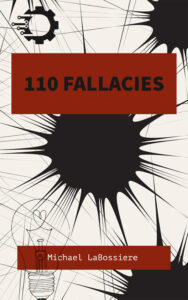
110 Fallacies on Amazon
Also Known as: Appeal to Anecdote
Description:
This fallacy is committed when a person draws a conclusion about a population based on an anecdote (a story) about one or a very small number of cases. The fallacy is also committed when someone rejects reasonable statistical data supporting a claim in favor of a single example or small number of examples that go against the claim. The fallacy is often considered a variation of Hasty Generalization. It has the following forms:
Form One
Premise 1: Anecdote A is told about a member M (or small number of members) of Population P.
Premise 2: Anecdote A says that M is (or is not) C.
Conclusion: Therefore, C is (or is not) true of Population P.
Form Two
Premise 1: Reasonable statistical evidence S exists for general claim C.
Premise 2: Anecdote A is presented that is an exception to or goes against general claim C.
Conclusion: General claim C is false
This fallacy is like Hasty Generalization in that a similar error is committed, namely drawing an inference based on a sample that is inadequate in size. One difference between Hasty Generalization and Anecdotal Evidence is that the fallacy of Anecdotal Evidence involves using a story (anecdote) as the sample. The more definitive distinction is that the second form of Anecdotal Evidence involves a rejection of statistical evidence for a general claim.
People often fall victim to this fallacy because stories and anecdotes usually have more psychological influence than statistical data. This persuasive force can cause people to infer that what is true in an anecdote must be true of the whole population or that an anecdote justifies rejecting statistical evidence. People often accept this fallacy because they would prefer that what is true in the anecdote be true for the whole population (a form of Wishful Thinking). For example, a person who smokes might try to convince herself that smoking will not hurt her because her Aunt Jane smoked 52 cigars a day and lived, cancer free, until she was 95.
People also fall for this fallacy when the anecdote matches their biases (positive or negative) or prejudices. For example, a person who fears and dislikes immigrants might believe that immigrants are likely to commit crimes because of an anecdote they hear about an immigrant who committed a crime. A person who has a very favorable view of immigrants might be swayed by an anecdote about an exceptional immigrant and infer that most immigrants will be exceptional.
As the example suggests, this sort of poor reasoning can be used in the context of causal reasoning. In addition to cases involving individual causation (such as Jane not getting cancer) this poor reasoning is commonly applied to causal claims about populations. What typically occurs is that a person rejects a general causal claim such as smoking causes cancer in favor of an anecdote in which a person smoked but did not get cancer. While this anecdote does show that not everyone who smokes gets cancer, it does not prove that smoking does not cause cancer.
This is because establishing that C is a causal factor for effect E in population P is a matter of showing that there would be more cases of E if all members of P were exposed to C than if none were. Showing that there are some anecdotal cases in which members of P were exposed to C but did not show effect E does not show that C does not cause E. In fact, that is what you should expect to see in most cases.
That said, the exceptions given in the anecdotes can provide a reason to be suspicious of a claimed causal connection, but this suspicion must be proportional to the evidence provided by the anecdote. For example, the fact that Alan Magee survived a fall of 20,000 feet from his B-17 bomber in WWII does show that a human can survive such a fall. However, it does not serve to disprove the general claim that falls from such great heights are usually fatal.
Anecdotes can also provide the basis for additional research. For example, the fact that some people can be exposed to certain pathogens without getting sick suggests that they would be worth examining to see how their immunity works and whether this could benefit the general population. As another example, the fact that people do sometimes survive falls from aircraft does provide a reason for investigating how this works and how this information might be useful.
Defense: The defense against the first version of this fallacy is to keep in mind that an anecdote does not prove or disprove a general claim. It is especially important to be on guard against anecdotes that have strong persuasive force, such as one that are very vivid or nicely line up with biases.
For the second version, the person committing it will ironically raise the red flag for this fallacy. They will admit that they are rejecting statistical evidence in favor of an anecdote. In effect, they are telling you to believe the one piece of evidence they like in favor of the weight of evidence they dislike. To avoid inflicting this fallacy on yourself, be on guard against the tendency to confuse the psychological force of an anecdote with its logical force.
Example #1
Jane: “Uncle Bill smoked a pack a day since he was 11 and he lived to be 90. So, all that science and medical talk about smoking being bad is just a bunch of garbage.”
Example #2
John: “Oh no! That woman is bringing pit bull into the dog park! Everyone get their dogs and run away!”
Sally: “Oh, don’t worry. I know that people think that pit bulls are aggressive and that there are all these statistics about them being dangerous dogs.”
John: “Yeah, that is why I’m leaving before your monster kills my dog.”
Sally: “But look at how sweet my pit bull Lady Buttercup is—she has never hurt anyone. So, all that bull about pit bulls being aggressive is just that: bull.”
Example #3
Bill: “Hey Sally, you look a bit under the weather.”
Sally: “Yeah, I think I’m getting a cold. In the summer. In Florida. This sucks.”
Bill: “My dad and I almost never get colds. You should do what we do.”
Sally: “What is that?”
Bill: “Drink red wine with every meal. My dad said that is the secret to avoiding colds. When I got old enough to buy wine, I started doing it.”
Sally: “Every meal? Even breakfast?”
Bill: “Yes.”
Sally: “Red wine goes with donuts?”
Bill: “It pairs perfectly.”
Ted: “That is baloney. I know a guy who did that and he had colds all the time. Now, this other guy told me that having a slice of cheese with every meal keeps the colds away. I never saw him so much as sniffle.”
Sally: “Why not just have wine and cheese every meal?”
Example #4
Fred: “You are wasting time studying.”
George: “What? Why aren’t you studying? The test is going to be hard.”
Fred: “No need.”
George: “You’re not going to cheat, are you?”
Fred: “No, of course not! But I heard about this woman, Keisha. She aced the last test. She went to the movies and forgot to study. So, I’m going with the Keisha Method—I just need to pick a movie and my A is assured.”
Example #5
Tucker: “Did you hear that story about the immigrant who killed that student?”
Sally: “I did. Terrible.”
Tucker: “So, I bet you’ll change your stance on immigration. After all, they are coming here to commit crimes and endangering Americans.”
Sally: “The statistics show otherwise.”
Tucker: “That is your opinion. That murder shows otherwise.”
Example #5
Sally: “Did you hear that story about the immigrant who saved ten Americans and is now attending medical school and law school at the same time?”
Tucker: “I did. Impressive.”
Sally: “So, I bet you’ll change your stance on immigration. After all, they are amazing people who will do great things.”

 This is the last of the virtual cheating series and the focus is on virtual people. The virtual aspect is easy enough to define; these are entities that exist entirely within the realm of computer memory and do not exist as physical beings in that they lack bodies of the traditional sort. They are, of course, physical beings in the broad sense, existing as data within physical memory systems.
This is the last of the virtual cheating series and the focus is on virtual people. The virtual aspect is easy enough to define; these are entities that exist entirely within the realm of computer memory and do not exist as physical beings in that they lack bodies of the traditional sort. They are, of course, physical beings in the broad sense, existing as data within physical memory systems.